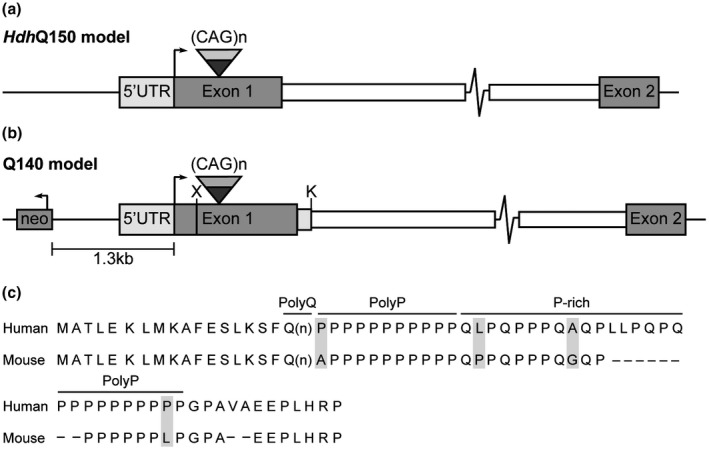Figure 6.

Genomic structures and protein sequence of the genetically modified Htt locus of Q140 and HdhQ150 knock‐in mice. (a and b) Schematics of the mutant Htt loci in the HdhQ150 and Q140 knock‐in mice. (a) In the HdhQ150 model, the mouse (CAG)2CAA(CAG)4 sequence has been replaced by an expanded CAG repeat by a double homologous recombination event that has left no other sequence modifications (Lin et al., 2001). (b) In the Q140 model, the XmnI—KpnI mouse Htt sequences have been replaced with the human XmnI—KpnI fragment (Levine et al., 1999). This left the amino acid sequence of the first 17 amino acids before the polyQ repeat unchanged, but the amino acid sequence following the polyQ differs between human and mouse HTT. In addition, 84 bp at the 5′ end of mouse intron 1 have been replaced with 10 bp from the 5′ end of human intron 1 and an intact neomycin resistance gene cassette (neo) located 1.3 kb 5′ to the initiation codon. X = XmnI, K = KpnI. (c) Alignment of the amino acid sequence of human and mouse exon 1 HTT. The first 17 amino acids before the polyQ repeat are identical in both species. The polyQ tract in human HTT is followed by a polyproline (polyP) repeat, a 17 amino acid proline‐rich (P‐rich) domain, a second polyP repeat and then 12 amino acids that terminate in a proline residue. In comparison, mouse HTT has a 6 amino acid deletion in the P‐rich domain (LLPQPQ), the second polyP repeat contains 6 rather than 10 residues, a dipeptide VA deletion in the 12 C‐terminal amino acids, as well as four substitutions (shown in gray). Neo = neomycin
